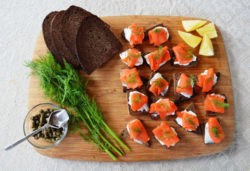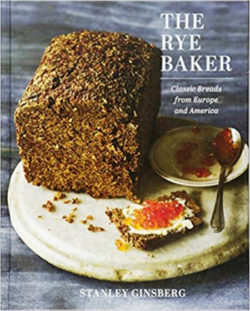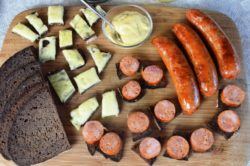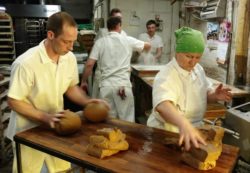Read Time: 4 Minutes Subscribe & Share
The Most Advanced Third World Country
John Melngallis
Founder, Black Rooster Foods
A Bread Is Born
When I first met John Melngallis, he was happily ensconced as an important professor of Electrical and Computor Engineering at the University of Maryland, and the American introduction of the rye bread from his homeland was a mere gleam in his eye. How this bread came to fruition in our backyard (and online as well) is a fascinating story. John’s family came to the US in 1949 from a German DP (displaced persons) camp, having fled the Russian takeover of Latvia. The Melngallis family was placed in a Western Pennsylvania town where work prospects were good, the one- room  school house happily welcomed the children, they had a roof over their heads, and bread on the table.
school house happily welcomed the children, they had a roof over their heads, and bread on the table.
But the bread….you can imagine their shock at the “wonderless bread” or its equivalent found in our grocery stores. As John noted, “We noticed that a hungry stray dog would not eat it.” His mother, who had never had to bake bread, set about the task of recreating the rupjmaize of her homeland. Unable to purchase whole-grain rye flour, she got a bushel of rye grain from a nearby farmer and found a neighbor who milled it for her (his mill was used for grinding corn for pig feed). And she ultimately succeeded through trial and error, memory and an old Latvian cookbook to produce a bread that had no nutrients removed by refining, no chemically derived “replacements,” and no preservatives added. Chances are, its shelf life was probably longer than Velveeta.
Bread For All, Not Just A Few
So, with retirement lurking around the corner, John began marketing this rupjmaize, first importing it from Latvia and finally locating a bakery in  Brooklyn that would produce this miracle bread to his exacting specifications. (Think for a moment about how exacting the specifications of a Computor Engineering Professor might be.) This has now come to be known as the Black Rooster Bread in our house, which we use as a vehicle for butter, cheese, smoked salmon, speck, and yes, even avocados and scrambled eggs. But John would like to pass along this gift of bread that has sustained Northern Europeans for centuries and spare us the health hazards that balloon bread has inflicted on the US population (particularly those who are poor). He would like his bread to be able to be purchased with food stamps as well as American Express Gold Cards.
Brooklyn that would produce this miracle bread to his exacting specifications. (Think for a moment about how exacting the specifications of a Computor Engineering Professor might be.) This has now come to be known as the Black Rooster Bread in our house, which we use as a vehicle for butter, cheese, smoked salmon, speck, and yes, even avocados and scrambled eggs. But John would like to pass along this gift of bread that has sustained Northern Europeans for centuries and spare us the health hazards that balloon bread has inflicted on the US population (particularly those who are poor). He would like his bread to be able to be purchased with food stamps as well as American Express Gold Cards.
Gluten, I Hardly Knew Ye
 And he has some thoughts on the current nutrient bogeyman: gluten. Although wheat, oats, barley, and rye are corralled into the herd of “gluten grains”, there are some differences in the role gluten plays in each. John researched an interesting book, “The Rye Baker” by Stanley Ginsberg, who breaks down in exacting detail how gluten is processed in rye versus wheat bread. According to Ginsberg (and he is backed up by other research), wheat bread depends on gluten to give it a porous structure, but the gluten hardens rather quickly, causing the bread to become stale. Rye bread, on the other hand, does not depend on gluten to give it structure but rather on a starchy gel which remains tender long after baking, and this explains why rye bread stays fresh for weeks. In addition, the rye kernel contains a lactic acid-producing bacteria as well as wild yeasts, which turn simple sugars into lactic acid, just as in yogurt, buttermilk, and sour cream. It is this combination of factors that results in the long shelf life of rye bread and the absence of mold. The gluten level of this rye is much lower than a similar loaf of wheat bread. Some with gluten intolerances can comfortably eat this style of rye bread.
And he has some thoughts on the current nutrient bogeyman: gluten. Although wheat, oats, barley, and rye are corralled into the herd of “gluten grains”, there are some differences in the role gluten plays in each. John researched an interesting book, “The Rye Baker” by Stanley Ginsberg, who breaks down in exacting detail how gluten is processed in rye versus wheat bread. According to Ginsberg (and he is backed up by other research), wheat bread depends on gluten to give it a porous structure, but the gluten hardens rather quickly, causing the bread to become stale. Rye bread, on the other hand, does not depend on gluten to give it structure but rather on a starchy gel which remains tender long after baking, and this explains why rye bread stays fresh for weeks. In addition, the rye kernel contains a lactic acid-producing bacteria as well as wild yeasts, which turn simple sugars into lactic acid, just as in yogurt, buttermilk, and sour cream. It is this combination of factors that results in the long shelf life of rye bread and the absence of mold. The gluten level of this rye is much lower than a similar loaf of wheat bread. Some with gluten intolerances can comfortably eat this style of rye bread.
Purchase And Enjoy Your Rupjmaize
John states, and we agree, that the density of the bread works best for open-face sandwiches and appetizers.  But it can be added to soups made with beets and other root vegetables either as a thickener (not unlike the Italian Pappa Al Pomodoro) or as a garnish of toasted croutons. There is a delicious version of the rye bread with dried fruits that Black Rooster produces, which makes a lovely sidekick to a cheese course. But, sometimes, just slather a slice with your favorite butter, and you will be happy and full. I get mine from Pescadeli and its sister store Butcher’s Alley. John’s website Black Rooster Foods gives you a Who’s Who list of stores to buy it, or you can purchase it directly from them online.
But it can be added to soups made with beets and other root vegetables either as a thickener (not unlike the Italian Pappa Al Pomodoro) or as a garnish of toasted croutons. There is a delicious version of the rye bread with dried fruits that Black Rooster produces, which makes a lovely sidekick to a cheese course. But, sometimes, just slather a slice with your favorite butter, and you will be happy and full. I get mine from Pescadeli and its sister store Butcher’s Alley. John’s website Black Rooster Foods gives you a Who’s Who list of stores to buy it, or you can purchase it directly from them online.

Kitchen Detail shares under the radar recipes, explores the art of cooking, the stories behind food, and the tools that bring it all together, while uncovering the social, political, and environmental truths that shape our culinary world.






Comments are closed here.
Follow this link to create a Kitchen Detail account so that you can leave comments!